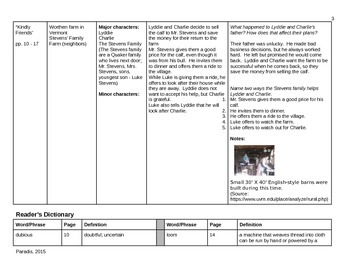Standards in this strand:

Key Ideas and Details:
CCSS.ELA-Literacy.RL.7.1
Cite several pieces of textual evidence to support analysis of what the text says explicitly as well as inferences drawn from the text.
Cite several pieces of textual evidence to support analysis of what the text says explicitly as well as inferences drawn from the text.
CCSS.ELA-Literacy.RL.7.2
Determine a theme or central idea of a text and analyze its development over the course of the text; provide an objective summary of the text.
Determine a theme or central idea of a text and analyze its development over the course of the text; provide an objective summary of the text.
CCSS.ELA-Literacy.RL.7.3
Analyze how particular elements of a story or drama interact (e.g., how setting shapes the characters or plot).
Analyze how particular elements of a story or drama interact (e.g., how setting shapes the characters or plot).
Easy and effective ELA lesson plans across all grades including social studies, writing and literature with free resouces from world-class teachers. 6th Grade ELA Standards Addressed: Conventions of Standard English 1. Demonstrate command of the conventions of standard English grammar and usage when writing or speaking. Knowledge of Language 3. Apply knowledge of language to understand how language functions in different contexts, to make effective choices for meaning or style, and to.
Craft and Structure:
CCSS.ELA-Literacy.RL.7.4
Determine the meaning of words and phrases as they are used in a text, including figurative and connotative meanings; analyze the impact of rhymes and other repetitions of sounds (e.g., alliteration) on a specific verse or stanza of a poem or section of a story or drama.
Determine the meaning of words and phrases as they are used in a text, including figurative and connotative meanings; analyze the impact of rhymes and other repetitions of sounds (e.g., alliteration) on a specific verse or stanza of a poem or section of a story or drama.
CCSS.ELA-Literacy.RL.7.5
Analyze how a drama's or poem's form or structure (e.g., soliloquy, sonnet) contributes to its meaning
Analyze how a drama's or poem's form or structure (e.g., soliloquy, sonnet) contributes to its meaning
CCSS.ELA-Literacy.RL.7.6
Analyze how an author develops and contrasts the points of view of different characters or narrators in a text.
Analyze how an author develops and contrasts the points of view of different characters or narrators in a text.


Integration of Knowledge and Ideas:
CCSS.ELA-Literacy.RL.7.7
Compare and contrast a written story, drama, or poem to its audio, filmed, staged, or multimedia version, analyzing the effects of techniques unique to each medium (e.g., lighting, sound, color, or camera focus and angles in a film).
Compare and contrast a written story, drama, or poem to its audio, filmed, staged, or multimedia version, analyzing the effects of techniques unique to each medium (e.g., lighting, sound, color, or camera focus and angles in a film).
CCSS.ELA-Literacy.RL.7.8
(RL.7.8 not applicable to literature)
(RL.7.8 not applicable to literature)

Chapters 22298th Grade Ela Page
CCSS.ELA-Literacy.RL.7.9
Compare and contrast a fictional portrayal of a time, place, or character and a historical account of the same period as a means of understanding how authors of fiction use or alter history.
Compare and contrast a fictional portrayal of a time, place, or character and a historical account of the same period as a means of understanding how authors of fiction use or alter history.

Chapters 22298th Grade Ela Pages
Range of Reading and Level of Text Complexity:
Chapters 22298th Grade Ela Page 18
CCSS.ELA-Literacy.RL.7.10
By the end of the year, read and comprehend literature, including stories, dramas, and poems, in the grades 6-8 text complexity band proficiently, with scaffolding as needed at the high end of the range.
By the end of the year, read and comprehend literature, including stories, dramas, and poems, in the grades 6-8 text complexity band proficiently, with scaffolding as needed at the high end of the range.